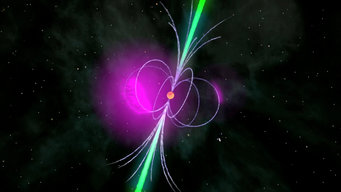Gamma-ray eclipses shed new light on spider pulsars
Seven rare eclipsing binaries identified and five neutron stars weighed
Mankind has watched the cosmic ballet of eclipses for millennia. Solar and lunar eclipses, those of Jupiter’s moons, and stellar occultations by planets and asteroids have also provided new physical measurements and insights about our Universe. Using NASA’s Fermi Gamma-ray Space Telescope, astronomers have now identified seven rare stellar binary systems in which a neutron star is eclipsed by its stellar companion. This allowed the international research team led by scientists from the Max Planck Institute for Gravitational Physics (Albert Einstein Institute) in Hannover to weigh those neutron stars. Their results were published in Nature Astronomy today. Precisely measuring neutron star masses improves our understanding of matter in extreme conditions and has implications for fundamental physics. In the future, these seven binary systems could also provide new opportunities to observe Einstein’s theory of general relativity in action.

“We have found seven binary systems in which a gamma-ray pulsar is eclipsed by its companion star. This lets us accurately measure the masses of five of those pulsars,” says Colin Clark, group leader at the Max Planck Institute for Gravitational Physics (Albert Einstein Institute) in Hannover, and lead author of the study published today in Nature Astronomy. “This became possible only now by carefully analyzing data from NASA’s Fermi Gamma-ray Space Telescope. Each mass measurement is an important data point for fundamental physics.”
Neutron stars are compact remnants of supernova explosions and consist of exotic, extremely dense matter. They measure about 20 kilometers across and weigh more than our Sun. Because of their strong magnetic fields and fast rotation they emit beamed radio waves and energetic gamma rays similar to a cosmic lighthouse. If these beams point towards Earth during the neutron star's rotation, it becomes visible as a pulsating radio or gamma-ray source: a radio or gamma-ray pulsar.
Spidery pulsars
“Spider pulsars” are very rare: fewer than 100 of almost 3,200 known pulsars are members of this exclusive species in the pulsar zoo. They consists of a pulsar in a binary system with a light-weight companion star. The pulsar vaporizes its companion with its radiation and a particle wind and over time destroys it entirely. These “black widow” or “redback” pulsars are named after spiders whose females are known for killing their lighter mates.
The material blown off the companion fills the binary system with plasma that is impenetrable to radio waves. The pulsar’s energetic gamma rays, however, are not stopped by the plasma and are observed by the Large Area Telescope (LAT) onboard NASA’s Fermi Gamma-ray Space Telescope.
Weighing a binary system
Fermi’s LAT detects single gamma-ray photons from these pulsars. With observations over many years, a precise map of the pulsar’s orbital motion can be drawn. Together with optical measurements of the companion’s motion it allows researchers to estimate the masses of both objects in the system.

The mass estimates, however, strongly depend on one missing piece of information: the “inclination” angle from which we view the binary system’s orbit. “We can only measure a star’s forward-and-backward speed, but not its side-to-side speed, making it impossible to distinguish between a large orbit viewed ‘face-on’ and a smaller orbit viewed from the side,” explains Clark.
The inclination can be estimated from optical observations of the companion. Its apparent brightness varies during an orbit depending on which side faces the Earth. The pulsar heats up one side of the companion, which appears brighter and more bluish. The companion is also distorted by the pulsar’s gravitational pull causing its apparent size to vary over the orbit. These observations are combined with astrophysical models of the system, allowing measurements of the inclination.
“Unfortunately, it seems that in some cases the models do not capture the complicated reality of how hot the companion is on which part of its surface. We have seen that this temperature distribution also can vary over time,” says Rene Breton, Professor of Astrophysics at the University of Manchester and co-author of the publication. “With reality being much more complex than the models, mass estimates based on optical observations are not always entirely trustworthy.”
But there is a possible fix for this problem. “If you observe a system in which the companion eclipses the pulsar, then you immediately know that we observe the binary system almost exactly from the side, from within its orbital plane,” explains Clark. “With the eclipse observations we can very reliably constrain the inclination.”

Seven discoveries
The research team sifted through more than 11 years of Fermi LAT observations to discover pulsars of an even rarer type: spider pulsars in which the companion star eclipses the gamma-ray pulsar. The astronomers analyzed Fermi LAT observations of 49 spider pulsar systems and found eclipses in 7 of them.
The duration of the eclipses allowed the researchers to independently constrain the inclination of the binary orbit. When an eclipse is observed and the orbital motions of the companion and the pulsar are measured, an upper limit on the pulsar mass can be set from the minimum duration of the eclipse. The lack of an observed eclipse can be translated into a lower limit on the pulsar mass.
Weighing five neutron stars and finding one surprise
For two of the seven eclipsing binary systems discovered, the confirmation of the neutron star as a pulsar is still pending. Thus, no precise map of the suspected pulsar’s orbital motion could be drawn for them and no mass estimates were possible. In four of the remaining five eclipsing systems, the new independent constraints on the inclination angle and therefore the mass estimates are consistent with previous results based on optical observations and modeling of the companion.
One system – the first spider pulsar ever discovered – held a surprise for the research team. To explain the observed eclipses it must be less than 6 degrees away from perfect alignment of the orbital plane with Fermi’s line of sight. This in turn means that the pulsar cannot weigh more than 1.8 times as much as our Sun. Previous optical observations and modeling implied an extremely high pulsar mass of 2.4 solar masses. The new lower bound is more consistent with the highest precisely measured neutron star masses.
Observing Einstein’s theory in action
The researchers point out that the eclipsing gamma-ray pulsars they identified might show another more exotic effect yet to be observed. When the companion eclipses the pulsar, the pulsar itself will pass in front of its companion half an orbit later. “We know from Einstein’s theory of general relativity that the neutron star’s strong gravity will bend the companion’s light like a lens, and that this will temporarily increase its apparent brightness,” says Clark. Observing this effect would provide another independent measurement of the pulsar mass. It is, however, expected to be too small to be easily detectable. “Teasing the neutron star’s gravitational lensing effect out of observations will require extremely sensitive observations and careful analysis, but it might just be on the borderline of what can be achieved with current technology. But in principle we know how to do this,” adds Clark.














